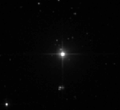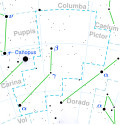 | A debris disk (American English), or debris disc (Commonwealth English), is a circumstellar disk of dust and debris in orbit around a star. Sometimes... 27 KB (2,357 words) - 13:42, 31 December 2023 |
 | Zeta Reticuli (section Alleged debris disk) coming from a two-lobed structure that looked like a debris disk seen edge-on. This debris disk interpreted as an analogy to the Kuiper belt with a semi-major... 24 KB (2,125 words) - 02:46, 13 February 2024 |
 | White dwarf (section Debris disks and planets) the white dwarf, until it will eventually sublimate and the disk will disappear. A debris disk will have a lifetime of around a few million years for white... 160 KB (18,161 words) - 19:57, 9 April 2024 |
piece of space debris falling to Earth leaves a fiery trail, just like a meteor. A debris disk is a circumstellar disk of dust and debris in orbit around... 9 KB (1,138 words) - 19:50, 21 April 2024 |
 | Vega (category Circumstellar disks) have a circumstellar disk of dust. This dust is likely to be the result of collisions between objects in an orbiting debris disk, which is analogous to... 90 KB (9,509 words) - 14:34, 12 April 2024 |
 | Pulsar planet (section Debris disks and precursors) interaction with a more massive one; the light white dwarf gives rise to a debris disk that generates a planet while the larger white dwarf becomes a pulsar... 45 KB (5,282 words) - 06:25, 24 April 2024 |
 | AU Microscopii (category Circumstellar disks) star. Like β Pictoris, AU Microscopii has a circumstellar disk of dust known as a debris disk and at least two exoplanets, with the presence of an additional... 35 KB (2,849 words) - 20:25, 19 April 2024 |
 | Fomalhaut (category Circumstellar disks) by several debris disks. The inner disk is a high-carbon small-grain (10–300 nm) ash disk, clustering at 0.1 AU from the star. Next is a disk of larger... 48 KB (4,575 words) - 13:06, 20 April 2024 |
 | Beta Pictoris (category Circumstellar disks) use of direct imagery. Both planets are orbiting in the plane of the debris disk surrounding the star. Beta Pictoris c is currently the closest extrasolar... 57 KB (6,099 words) - 22:44, 2 February 2024 |

